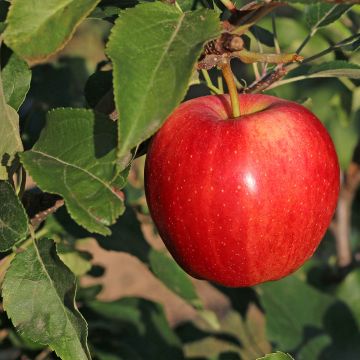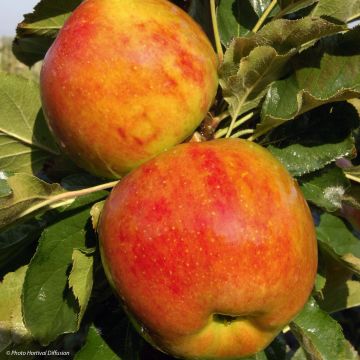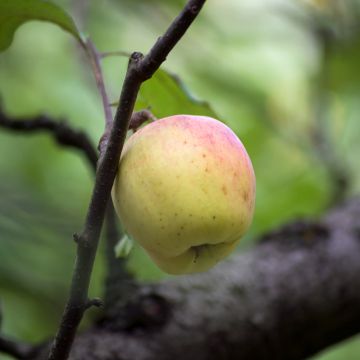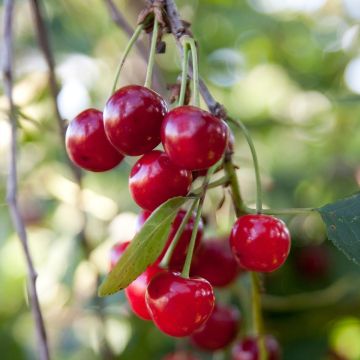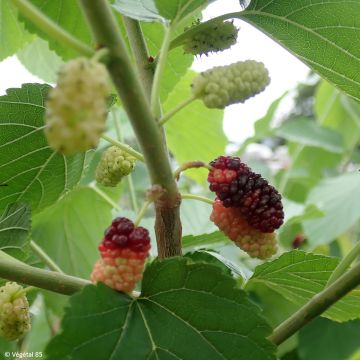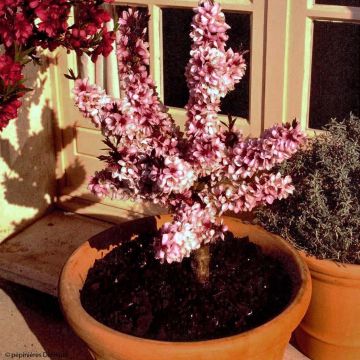

Malus domestica Delicado
Malus domestica Delicado
Malus domestica Delicado
Apple, Orchard Apple
This item cannot be shipped to the selected country
Delivery charge from €5.90
More information
Schedule delivery date,
and select date in basket
This plant carries a 6 months recovery warranty
More information
We guarantee the quality of our plants for a full growing cycle, and will replace at our expense any plant that fails to recover under normal climatic and planting conditions.
From €5.90 for pickup delivery and €6.90 for home delivery
Express home delivery from €8.90.
Description
The 'Delicado' Dwarf Apple Tree is a variety that is both compact and slow-growing, reaching a height of 1.70 or 1.80 metres (6 feet) after many years. Its compact growth doesn't prevent it from being very fruitful, as long as it is placed near other Apple tree varieties, as it is not self-fertile. We appreciate its beautiful spring flowering in a pale pinkish white colour that brightens up the days in April and May. And above all, we love its yellow and red fruits, fragrant and sweet, with a touch of acidity, which ripen from August onwards. Hardy, it can be grown in a pot on a terrace or even a balcony, or planted in most ordinary soils.
Malus domestica, or Common Apple Tree, is a member of the Rosaceae family, like most of our other fruit trees (Pear tree, Apricot tree, Plum tree...). Present in Europe since ancient times, it is a fruit tree native to the forests of Central Asia. It is highly hardy, probably the most cultivated fruit tree in Northern Europe, with around 20,000 varieties worldwide, making it a plant of great economic importance.
The variety 'Delicado' is part of the range of miniature fruit trees which is gradually expanding with the growing trend of terraces, balconies, and patios. These living spaces are no longer reserved for ornamental plants, and dwarf fruit trees like 'Delicado', which offer both ornamental flowering and edible fruits, have their rightful place there. 'Delicado' has a slow growth, only about 10 to 20cm (4 to 8in) per year. It takes about 15 years to reach its maximum development, reaching approximately 1.80 metres (6 feet) in height and 1 to 1.20 metres (3 to 4 feet) in width. It is possible to further limit its dimensions to 1.50 metres (5 feet) in height by lightly pruning it if space is really limited. Its vegetation consists of medium to dark green oval-shaped leaves with serrated edges, which turn yellow in autumn. The flowering appears and blooms in April-May in the form of simple flowers with 5 rounded petals, measuring 2 to 3cm (1in) in diameter. Slightly pinkish white, these simple flowers have a true charm with a romantic inspiration.
Since this variety is not self-fertile, the flowers must be pollinated by the pollen from other Apple trees nearby. The best pollinating varieties for 'Delicado' are the classic 'Cox's Orange', the variety 'James Grieve', and the 'Topaz' Apple Tree, with its bright red fruits. When pollinated, the flowers will produce numerous medium-sized apples, with yellow skin turning red on the side exposed to the sun. They ripen from August depending on the climate zone, and in September, and are excellent for eating. Their flesh is juicy and aromatic, both sweet and slightly acidic. Thanks to its compact habit, even children can harvest them without needing to climb a ladder.
Hardy to approximately -20°C (-4°F), this dwarf tree requires very little maintenance. Sunlight and regular watering will make it happy, and you just need to keep an eye on its health to intervene in case of aphid attack or other issues. Very easy to grow in a pot, requiring minimal pruning, it tolerates the urban atmosphere well. It is the ideal dwarf fruit tree for city dwellers.
Thanks to dwarf fruit trees like this 'Delicado' Apple Tree, it is easy to create a mini orchard to enjoy your own pears, peaches, or cherries. For example, the Fruit Me Peach Me Red Dwarf Peach Tree, a self-fertile variety with quick fruiting, will give you delicious yellow-fleshed peaches in summer, and also reward you with beautiful pink flowering in spring. The 'Sylvia' Columnar Cherry Tree, with its very graphic habit and also self-fertile, produces white flowers in April, which then develop into beautiful bright red cherries with sweet and crunchy flesh. Among the Pear trees, the famous 'Belle Hélène' is available in a dwarf version, offering its renowned fruits of the same size as the normal-sized variety. In addition to these fruit trees, also consider adopting some aromatic plants that will accompany your dishes in the kitchen...
Report an error about the product description
Malus domestica Delicado in pictures


Plant habit
Fruit
Flowering
Foliage
Botanical data
Malus
domestica
Delicado
Rosaceae
Apple, Orchard Apple
Cultivar or hybrid
Other Apple trees
Planting and care
Choose a well-sunlit location for your 'Delicado' dwarf apple tree. The soil can be slightly limestone or acidic, but not excessively. Dig a wide planting hole at least 3 times the volume of the root ball. Simultaneously add organic matter (potting soil, compost...) and a base fertilizer like crushed horn. Do not bury the graft collar and stake if necessary. Soak the root ball in a bucket for fifteen minutes before planting, then water abundantly, even in winter and even if it rains. Fruit trees are ideally planted between October and March, outside of the freezing period. Container-grown plants can be planted year-round, except during periods of high heat or frost.
The advantage of dwarf fruit trees is that they can be planted in pots or containers for outdoor use. Choose a container of at least 60L. Make sure the container has drainage holes and create good drainage by filling the bottom with a thick layer of clay pellets or gravel. In pots, your trees will naturally require more regular watering. During winter, move your fruit trees to a sheltered location away from the wind and stop watering during frost periods. Practice repotting at least every two years, which involves replacing at least the topsoil with fresh soil, and fertilize before flowering with a special fertilizer that is not too rich in nitrogen.
In winter, at the base of the tree and lightly incorporated into the soil surface, you can add a small scoop of wood ash, rich in potassium, to improve fruiting. Apple trees can be susceptible to various diseases and pests. To limit risks, space the trees sufficiently apart, plant multi-species hedges, birdhouses, or insect hotels to attract beneficial insects. In summary, prioritize diversity. The main diseases of apple trees are scab (brown spots on leaves), brown rot (wilting of flowers and rotting of fruits on the tree), and powdery mildew (white fuzz on leaves). For these three cases, preventive action is preferred by spraying a horsetail decoction. As a last resort and in the case of severe attacks, you can apply a treatment based on Bordeaux mixture. As for pests, the codling moth (or fruit worm) is a small caterpillar that tunnels inside the fruit, hatched from a butterfly egg. To remedy this, it is preferable to act preventively by promoting the installation of tits and bats through the placement of nest boxes. In case of aphid infestation, spray a solution based on black soap.
During harvest in September, only keep picked fruits. For proper storage, it is preferable to place the apple with its stem downwards, on shelves or in crates. Choose a location that is preferably completely dark, dry, cool, but frost-free.
Planting period
Intended location
Care
This item has not been reviewed yet - be the first to leave a review about it.
Fruit trees for small gardens
Haven't found what you were looking for?
Hardiness is the lowest winter temperature a plant can endure without suffering serious damage or even dying. However, hardiness is affected by location (a sheltered area, such as a patio), protection (winter cover) and soil type (hardiness is improved by well-drained soil).

Photo Sharing Terms & Conditions
In order to encourage gardeners to interact and share their experiences, Promesse de fleurs offers various media enabling content to be uploaded onto its Site - in particular via the ‘Photo sharing’ module.
The User agrees to refrain from:
- Posting any content that is illegal, prejudicial, insulting, racist, inciteful to hatred, revisionist, contrary to public decency, that infringes on privacy or on the privacy rights of third parties, in particular the publicity rights of persons and goods, intellectual property rights, or the right to privacy.
- Submitting content on behalf of a third party;
- Impersonate the identity of a third party and/or publish any personal information about a third party;
In general, the User undertakes to refrain from any unethical behaviour.
All Content (in particular text, comments, files, images, photos, videos, creative works, etc.), which may be subject to property or intellectual property rights, image or other private rights, shall remain the property of the User, subject to the limited rights granted by the terms of the licence granted by Promesse de fleurs as stated below. Users are at liberty to publish or not to publish such Content on the Site, notably via the ‘Photo Sharing’ facility, and accept that this Content shall be made public and freely accessible, notably on the Internet.
Users further acknowledge, undertake to have ,and guarantee that they hold all necessary rights and permissions to publish such material on the Site, in particular with regard to the legislation in force pertaining to any privacy, property, intellectual property, image, or contractual rights, or rights of any other nature. By publishing such Content on the Site, Users acknowledge accepting full liability as publishers of the Content within the meaning of the law, and grant Promesse de fleurs, free of charge, an inclusive, worldwide licence for the said Content for the entire duration of its publication, including all reproduction, representation, up/downloading, displaying, performing, transmission, and storage rights.
Users also grant permission for their name to be linked to the Content and accept that this link may not always be made available.
By engaging in posting material, Users consent to their Content becoming automatically accessible on the Internet, in particular on other sites and/or blogs and/or web pages of the Promesse de fleurs site, including in particular social pages and the Promesse de fleurs catalogue.
Users may secure the removal of entrusted content free of charge by issuing a simple request via our contact form.
The flowering period indicated on our website applies to countries and regions located in USDA zone 8 (France, the United Kingdom, Ireland, the Netherlands, etc.)
It will vary according to where you live:
- In zones 9 to 10 (Italy, Spain, Greece, etc.), flowering will occur about 2 to 4 weeks earlier.
- In zones 6 to 7 (Germany, Poland, Slovenia, and lower mountainous regions), flowering will be delayed by 2 to 3 weeks.
- In zone 5 (Central Europe, Scandinavia), blooming will be delayed by 3 to 5 weeks.
In temperate climates, pruning of spring-flowering shrubs (forsythia, spireas, etc.) should be done just after flowering.
Pruning of summer-flowering shrubs (Indian Lilac, Perovskia, etc.) can be done in winter or spring.
In cold regions as well as with frost-sensitive plants, avoid pruning too early when severe frosts may still occur.
The planting period indicated on our website applies to countries and regions located in USDA zone 8 (France, United Kingdom, Ireland, Netherlands).
It will vary according to where you live:
- In Mediterranean zones (Marseille, Madrid, Milan, etc.), autumn and winter are the best planting periods.
- In continental zones (Strasbourg, Munich, Vienna, etc.), delay planting by 2 to 3 weeks in spring and bring it forward by 2 to 4 weeks in autumn.
- In mountainous regions (the Alps, Pyrenees, Carpathians, etc.), it is best to plant in late spring (May-June) or late summer (August-September).
The harvesting period indicated on our website applies to countries and regions in USDA zone 8 (France, England, Ireland, the Netherlands).
In colder areas (Scandinavia, Poland, Austria...) fruit and vegetable harvests are likely to be delayed by 3-4 weeks.
In warmer areas (Italy, Spain, Greece, etc.), harvesting will probably take place earlier, depending on weather conditions.
The sowing periods indicated on our website apply to countries and regions within USDA Zone 8 (France, UK, Ireland, Netherlands).
In colder areas (Scandinavia, Poland, Austria...), delay any outdoor sowing by 3-4 weeks, or sow under glass.
In warmer climes (Italy, Spain, Greece, etc.), bring outdoor sowing forward by a few weeks.



































